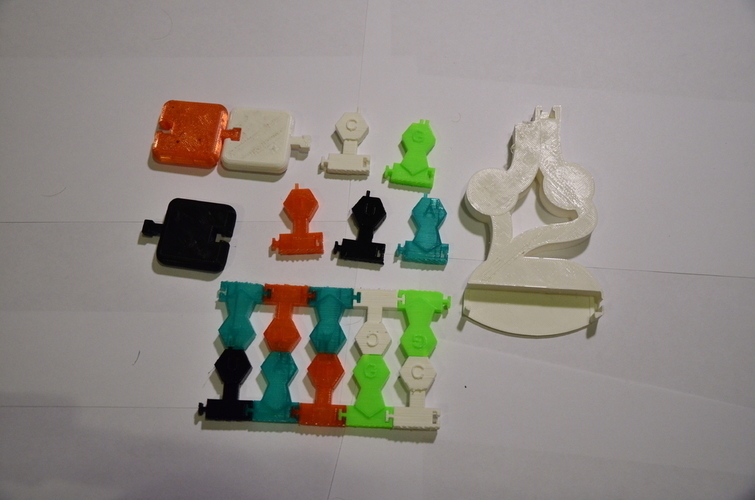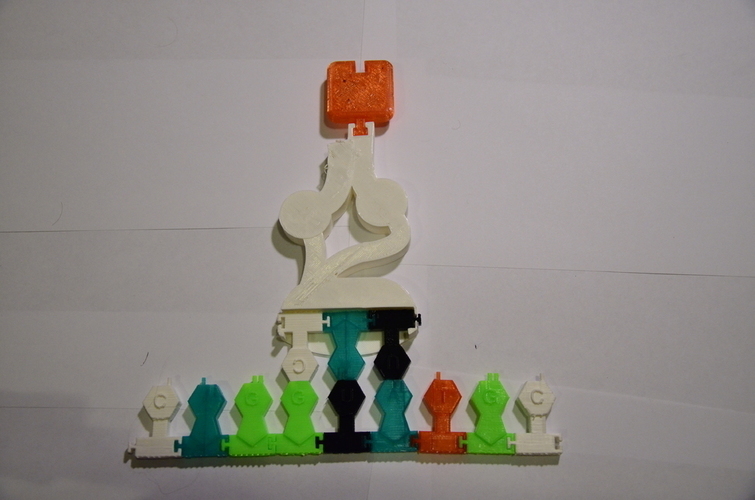

Prints (0)
-
No Prints Yet
Be the first to upload a Print for this Design!
Description
This set is designed to allow students to learn about DNA and RNA through playing with the blocks as well as to serve as a manipulative to model processes that involve DNA (described below). The set is designed so both visually impaired and sighted students can learn about DNA, replication, and transcription by playing with the building kit as described below. Each nucleotide block contains the raised letter symbol and shape of its corresponding base (either a purine or pyrimidine). Students can both feel and see the approximate shapes of these molecules. The posts and holes at the top of each piece represent the number of hydrogen bond donors (the posts) and acceptors (holes) that each base has. The number and type of the hydrogen bond donors and acceptors determine which bases are able to pair in a DNA molecule. The nucleotide blocks link together at the bottom in order to form the DNA or RNA backbone. The tops of each block can connect together to show hydrogen bonding with a complementary DNA or RNA strand. Blocks are designed so that only the correct pairs can connect (A with T, A with U, G with C). Students can learn about the structure of DNA and base pairing just by figuring out how the blocks can and cannot fit together without any previous instruction. All pieces can only be connected in the correct orientation so students can tell by feel whether or not two pieces should connect. The tRNA models are included so that the kit can be used to show the processes of transcription and translation. After making a model of double stranded DNA, the strands can be split and a complimentary mRNA strand can be built (substituting uracil for thymine). This mRNA strand is then removed. The anticodon on the tRNA models can be customized by inserting a sequence of three nucleotide blocks that pair with the sequence on the mRNA strand. Each anticodon matches a different amino acid block that can be linked to the top of the tRNA model. The tRNA models can then be bound to the mRNA strand and the amino acid blocks linked to form a protein. The set can also be used as a way to teach how DNA mutations such as deletions, insertions, and frame-shifts affect the final amino acid sequence for the protein coded by the DNA. A blocking group is also included in order to demonstrate how DNA sequencing is done.
Print Settings Printer: Da Vinci Jr. Rafts: Yes Supports: Yes Resolution: .2mm Infill: 5-10% Notes: Rafts and supports are only needed for printing the nucleic acid blocks.
Standards
NGSS
CCSS
Overview and Background Objectives: Students will be able to describe the way in which nucleotides hydrogen bond in specific pairs. Students will be able to describe what happens to DNA structure when a base pair is mis-matched. Students will be able to build complimentary DNA and mRNA strands to a pre-built template DNA strand. Students will be able to describe the processes of transcription and translation. Students will be able to describe the process by which proteins are made from DNA Students will be able to describe the different roles RNA can play (mRNA, tRNA, rRNA) Students will be able to describe the difference between purines and pyrimidines. Students will be able to describe the different ways that DNA can mutate (deletions, insertions, etc.) and how these effect the final protein product. Students will be able to recognize start, stop codons, as well as be able to describe how each tRNA has a specific anticodon that codes for only one amino acid. Preparation and pre teaching: Students should be familiar with nucleic acid base pairing as well as the basic properties and structures of DNA, mRNA, tRNA, and ribosomes. The kit can be used to teach concepts such as transcription, translation, base pairing, DNA replication, mutations, etc so exactly what needs to be pre-taught will depend on how the blocks are being used. Students can also be given the kit with very little explanation and allowed to figure out the structure of DNA and relationships between the nucleotides on their own.
Lesson Plan and Activity: The following is a description of how transcription and translation can be modeled using the set. As described in the summary, the set can be used to model a wide variety of concepts for DNA and RNA. Create a template DNA strand from the blocks. (You can choose the sequence of DNA to reflect a specific sequence of amino acids as well as a stop codon if you want to focus on protein structure or the effects of mutations on the final protein). Students must use the nucleotide blocks to create a complimentary mRNA strand that can leave the nucleus and go to the ribosome. Either set up the needed tRNA molecules with the correct anti-codons and amino acids attached or have students create these. Demonstrate how the first tRNA binds to the mRNA while it is in the ribosome, moves over, then the next one binds. The amino acids then transfer to the new tRNA and the old one leaves. This process then repeats. Compare how different DNA sequences lead to different amino acid sequences. Additional Lessons: -mRNA processing steps can also be integrated into this lesson -The effects of mutations on transcription and translation, such as deletions and frame shifts, can be illustrated with the model. Materials Needed No materials besides the model kit are needed.
Comments